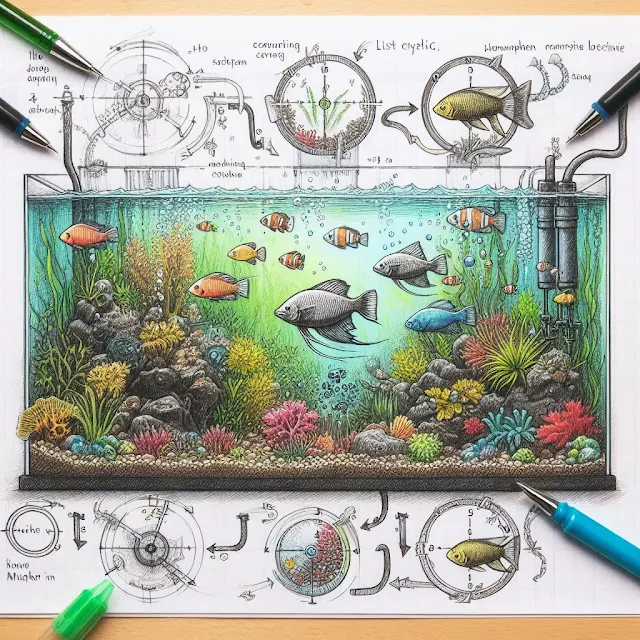How to Fishless Cycle Your Aquarium: A Step-by-Step Guide
How to Fishless Cycle Your Aquarium: A Step-by-Step Guide
Fishless cycling is an essential process for establishing a healthy environment in your aquarium before introducing fish. This method avoids the stress and potential harm that fish can experience during the traditional cycling process. In this guide, we'll walk you through the steps of fishless cycling, ensuring that your tank is ready for its aquatic inhabitants.
Understanding Fishless Cycling
Before diving into the steps, it's crucial to understand what fishless cycling is and why it's important. Cycling an aquarium means establishing a colony of beneficial bacteria that break down harmful ammonia into less toxic substances like nitrites and nitrates. Fishless cycling achieves this without using live fish, making it a humane and effective way to prepare your tank.
1. Gather Your Supplies
To start fishless cycling, you will need the following items:
- An Aquarium: Make sure it’s properly set up with a filter, heater, and substrate.
- Ammonia: Pure ammonia without any additives is essential for simulating fish waste.
- Water Test Kit: A kit to measure ammonia, nitrite, and nitrate levels.
- Dechlorinator: To remove chlorine from tap water, which can harm beneficial bacteria.
- Beneficial Bacteria Supplement (Optional): To speed up the cycling process.
Having these supplies ready will ensure a smooth and effective cycling process.
2. Set Up Your Aquarium
Begin by setting up your aquarium with all the necessary equipment. This includes installing the filter, heater, and adding the substrate. Ensure that everything is running smoothly and that the water temperature is stable. You’ll want to maintain a temperature of around 75-80°F (24-27°C), as this is ideal for beneficial bacteria growth.
3. Add Ammonia to the Tank
Now, it's time to add ammonia to your tank. The goal is to simulate the waste that fish would produce. Start by adding ammonia until you reach a concentration of about 2-4 ppm (parts per million). You can test this using your water test kit. Be cautious not to add too much, as excessively high levels can stall the cycling process.
4. Test Ammonia Levels Regularly
After adding ammonia, it's essential to monitor the levels daily. Use your water test kit to check the ammonia concentration in the tank. Initially, you'll notice that the ammonia level remains high, but over time, it will start to decrease as beneficial bacteria begin to process it.
5. Observe Nitrite Spike
As the beneficial bacteria start breaking down ammonia, you'll notice a rise in nitrite levels. This is a sign that the cycling process is progressing. Nitrite is also toxic to fish, so it's crucial to continue the fishless cycling process until nitrite levels drop to zero.
6. Wait for Nitrate Levels to Rise
The next step in the cycling process is the conversion of nitrites into nitrates. Nitrates are less harmful to fish and are the final product of the nitrogen cycle. You should observe a gradual increase in nitrate levels, which indicates that the cycle is nearing completion.
7. Perform Water Changes
Once your nitrate levels have risen, it's time to perform a partial water change. This will help lower the nitrate concentration and prepare the tank for your fish. Aim to change about 50% of the water in the tank, and make sure to dechlorinate the new water before adding it.
8. Test Your Water Parameters Again
After the water change, test your water parameters again. Your ammonia and nitrite levels should be at zero, and nitrates should be present but at a safe level (typically below 40 ppm). If these conditions are met, your tank is fully cycled and ready for fish.
9. Add Fish Gradually
Now that your tank is cycled, you can start adding fish. However, it's essential to introduce them gradually to avoid overwhelming the beneficial bacteria. Start with a small number of fish and monitor the water parameters regularly to ensure the tank remains stable.
10. Maintain Your Aquarium
Even after your tank is fully cycled, regular maintenance is crucial to keep it healthy. Perform regular water changes, clean the filter, and continue monitoring water parameters. This will help prevent any spikes in ammonia or nitrite levels and ensure a safe environment for your fish.
Common Mistakes to Avoid During Fishless Cycling
Fishless cycling is straightforward, but there are some common mistakes that you should avoid:
- Adding Too Much Ammonia: Excessive ammonia can stall the cycling process. Stick to the recommended 2-4 ppm range.
- Not Testing Water Regularly: Frequent testing is essential to track the progress of the cycle.
- Skipping Water Changes: High nitrate levels can be harmful, so don't skip water changes.
- Rushing the Process: Cycling can take several weeks. Patience is key to a successful fishless cycle.
Benefits of Fishless Cycling
Fishless cycling offers several advantages over traditional cycling methods:
- Humane: It avoids exposing fish to harmful ammonia and nitrites.
- Effective: It establishes a strong bacterial colony before adding fish, reducing the risk of ammonia spikes.
- Control: You have complete control over the process, allowing you to monitor and adjust as needed.
Conclusion
Fishless cycling is a responsible and effective way to prepare your aquarium for fish. By following these steps, you can ensure that your tank is fully cycled and ready to provide a healthy environment for your aquatic pets. Remember to be patient, test your water regularly, and perform necessary maintenance to keep your aquarium thriving.






